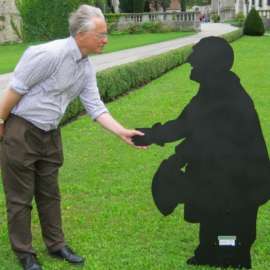Aleksandar Djermanović was apparently tucking into his breakfast on Saturday morning when the telephone rang, and he was asked if he could perform Chopin’s Piano Concerto no. 1. I imagine him joyfully saying yes, and then asking when, already working out his rehearsal schedule in his mind, whereupon he was confronted with the astounding reply, “This afternoon, in Tunbridge Wells.” The pre-concert announcement informed us that Lara Melda, the scheduled pianist, had succumbed to “a winter illness” the previous evening: a swift replacement was required. One can imagine the panic, and then the relief when Djermanović was found and agreed to step into the breach, with no change of programme.
This is a “non-professional” orchestra, so one might expect some surprises in the quality of the playing, but the cellos’ presentation of the jaunty folksy opening theme of Hamish MacCunn’s overture was very attractively done, with crisp articulation. The most welcome surprise was the horn solo in the central section which was beautifully accomplished. In a concert with Bruckner’s Fourth Symphony, any evidence that the horns were up to the task is reassuring, and David Lee, who played first horn, is in no sense a non-professional. The orchestra brought the overture to a rousing close, embellished by the only cymbal clashes of the evening.
Enter the saviour of the day, Djermanović, obliged to sit silent at his piano whilst the orchestra deliver Chopin’s atmospheric introduction of the movement’s themes. It’s a difficult opening to bring off as everyone, including Chopin, seems to be waiting for the piano to come in, and it sounded just a little lacklustre. Djermanović (playing from memory!) began a little uneasily, a touch wooden – nervous, no doubt, and who wouldn’t be? – but as the movement progressed he became more and more fluid and the performance grew in stature. It was certainly not a wilting, overexpressive view of Chopin, nor was it overcome by virtuoso bombast, but it had an admirable restraint which leant it a nobility not always brought to this music. The slow movement passed like a melancholy dream, but always avoiding sentimentality, and the Rondo: Vivace, though perhaps a bit short on Vivace, had a very attractive lilt to it – whether this was an interpretative decision, or making a virtue of necessity given the limited rehearsal time, I don’t know, but it rounded off what was a remarkably impressive performance. I’ve since learnt that the soloist had only ever played the concerto with an orchestra once before: you wouldn’t have known. His interpretation seemed considered and searching, and allowed the expressive musical quality of the work to speak unencumbered by exaggerated interventions.
The programme note by Marjorie Vinall warned us to expect the Bruckner symphony to open “with a very quiet scrubbing on the strings”. Fortunately the strings managed a tremolo that rose above mere scrubbing and created wonderfully that atmospheric space into which the horn sounds its magical call and sets the movement on its way. Conductor Neil Thomson immediately revealed his skill in the management of the crescendo of the first theme group, and the whole exposition paragraph was nicely shaped. The second theme, a birdcall-based string theme, could perhaps have been a touch lighter and more beguiling, but overall the power and vision of the movement came through very strongly. At the very end the four horns repeatedly blare out fortissimo the opening horn call, and they blew for all they were worth, even managing a crescendo for their final long-held note – very exhilarating!
The Andante commences with a halting march-like figure on muted violins and violas, and once again the crisp articulation of the strings was noticeable. The cellos then bring to this the broad and beautiful main theme, which the large cello section did very beautifully indeed. The second theme is a big moment for the viola section, and although one could sense their visionary aspiration, they were somewhat hampered by problems of intonation. The climax of the movement, and the short coda with very quiet drum beats was spellbinding. The Scherzo’s sprightly tapestry of overlaid horn calls they accomplished at a good pace.
The Finale is a large movement that Bruckner wrote later to replace his earlier version. The previous finale he entitled “Volksfest”, a people’s festival or funfair, and it leant to the symphony a light, pastoral air. This later finale is something much grander and Neil Thompson unleashed its opening paragraph with mighty splendour. There are versions of the score that cap it with a cymbal clash, and having heard the cymbals at work in MacCunn’s overture I thought maybe they might return for the Bruckner. In the event it would have been quite superfluous given the powerful climax Thomson and his orchestra were able to generate unembellished by exotic percussion. Nothing in this melody and drama packed movement was short-changed, and the closing pages, with the return of the opening horn call on full brass above frenetic high string triplets, brought the work to a blazing close.
Bruckner symphonies can be challenging to any orchestra and conductor. The RTWSO and Neil Thomson acquitted themselves handsomely and gave the Tunbridge Wells audience a wonderful opportunity to hear this great and glorious work.


